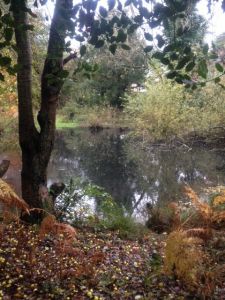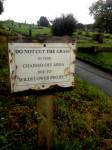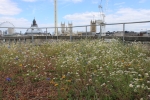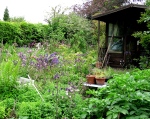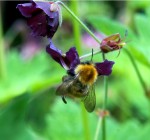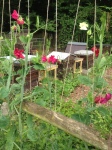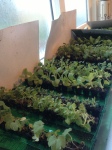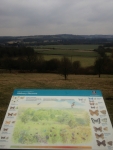Have you ever thought – what is the difference between a pond and a lake? And what’s the difference between a pond and a wild life pond? These along with many other questions were raised by Rod d’Ayala, an ecological consultant running a fascinating day course on pond restoration and management which I attended a few months ago.
Over the last century half a million natural ponds have been lost and as two thirds of all freshwater species are supported by ponds this has resulted in a great decline in UK amphibians. Whilst there has been a renewed effort to improve pond numbers in the last decade resulting in a slight increase, their quality as wild life ponds supporting a diverse range of aquatic plants, amphibians, invertebrates and reptiles is unfortunately diminishing. Over 80% of the remaining UK ponds are in a poor state. (Source: Freshwater Habitats Trust)
A ‘pond’ and a ‘wild life pond are two very different things. Whilst we may think the ideal pond is an open watery expanse with resident ducks, fish and grassy banks – this perfect picturesque village pond is likely to be polluted, nutrient rich and wild life poor. Our natural ponds in the countryside are also often in a poor state. They regularly suffer from water and chemical pollutant run off from fields and road sides and usually exist as isolated pools with little or no beneficial access for surrounding wild life.
A wild life pond needs clean rainwater not run off from land, roads or pathways which can carry silt, pollutants and chemicals directly into the pond. It also requires good wild life surrounds which encompass variation in habitats and structures. It’s vital that correct aquatic planting is practiced – only using uk natives plants in public ponds – combining the correct ratio of marginals and oxygenators in the depths, shallows and pond edges to provide a diverse range of conditions. Which in turn maximises species diversity and numbers. And all wild life ponds benefit hugely when situated close to other wild life ponds, as each one will offer different depths of water, temperature and conditions at different times of the year allowing species to migrate as required.
Therefore the ideal is a network of ponds and ponds near clean river systems. This allows for individual species to move and recover when conditions are adverse in their original pond allowing overall numbers in the network to remain healthy. The Million Ponds Project is an attempt to redress the balance and restore a million clean water countryside ponds with suitable surrounding habitat to support a diverse range of species. So far the Freshwater Habitats Trust has coordinated the creation of a 1000 clean water ponds for wildlife in collaboration with land owners and land managers. Public donations and a grant from Biffa Award has paid for the work thus far but further donations are required to continue this valuable work for UK conservation.
Rod argues that another problem that wild life ponds face is human intervention at the wrong time. Once a pond becomes overgrown and less aesthetically pleasing we tend to want to clear out the excess vegetation and dredge the bottom of silt as part of a restoration process for the benefit of the pond and it’s wild life. This is often carried out by councils, landowners and farmers with the best intentions but we perhaps need to accept that ponds are successional habitats. Like all things ponds have a life span and over time animals and plants colonise them and this is perfectly natural. Plants grow in from the margins towards the centre, sediment accumulates, water depth reduces and permanent ponds become temporary.
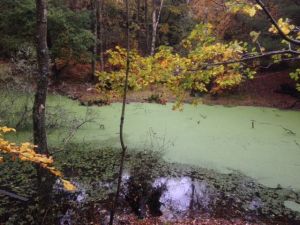 It’s worth remembering that it takes just 10 cm of fresh pond water for most invertebrates to occur and thrive. And temporary ponds are part of the ebb and flow of some wildlife pond life cycles. When a temporary pond bed dries out it allows organic leaf debris to break down and so maintains a consistent water level when it refills. Whilst permanent ponds ultimately fill up with organic debris which is unable to break down fully in water and over time reduces water levels to a point of drying up completely.
It’s worth remembering that it takes just 10 cm of fresh pond water for most invertebrates to occur and thrive. And temporary ponds are part of the ebb and flow of some wildlife pond life cycles. When a temporary pond bed dries out it allows organic leaf debris to break down and so maintains a consistent water level when it refills. Whilst permanent ponds ultimately fill up with organic debris which is unable to break down fully in water and over time reduces water levels to a point of drying up completely.
And by the way – “a pond is a natural or artificial still water body of up to 5 acres that holds water for up to 4 months a year. Whereas, a lake is a permanent large body of water over 5 acres with significant wave action stratification of water” Rod d’Ayala.
For further information on:
- habitat and species surveys
- habitat creation, management, advice and planning
- protected species work
- talks, walks and teaching
- Million Ponds Project
- Pond conservation
- Amphibian and Reptile Conservation Trust
- Freshwater Habitats Trust
www.arc-trust.org/projects/archived/million-ponds

